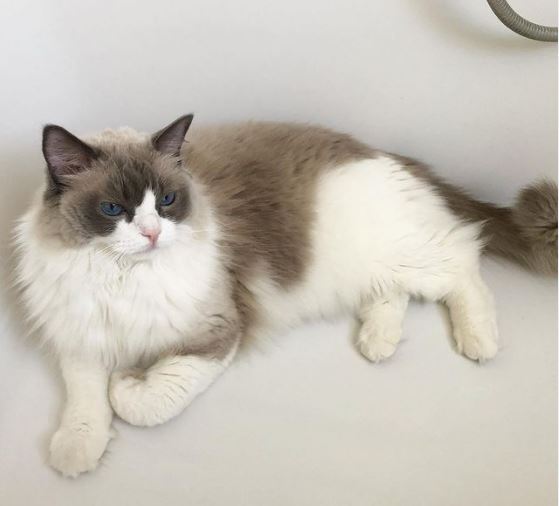Ragdolls are friendly and social cats, often enjoying playful companionship and positive relationships with other felines. Their amiable nature makes them inclined to get along well with other cats in a household. Factors like cat hierarchy, socialization, and behavioral cues influence their compatibility.
It’s important to introduce Ragdolls to other cats gradually and monitor for any signs of aggression or stress. Look for positive body language, friendly interactions, and shared resting spaces as signs of successful interactions. Managing potential challenges and seeking professional advice can help in fostering strong bonds between Ragdolls and other cats.
Ragdolls’ Social Nature
Ragdolls generally exhibit a friendly and sociable nature towards other cats. They thrive on playful companionship and enjoy engaging in feline friendships within group dynamics. To foster positive relationships between Ragdolls and other cats, effective socialization techniques are important.
Encouraging interactions through supervised play sessions can help Ragdolls build bonds with their feline companions. By understanding and respecting the unique group dynamics among cats, owners can create a harmonious environment where Ragdolls can thrive socially.
Providing opportunities for Ragdolls to engage in cooperative play and establish relationships based on mutual respect is vital. With the right socialization and support, Ragdolls can develop strong friendships with other cats, enhancing their overall well-being and happiness.
Factors Affecting Compatibility
When introducing new cats to a household, taking into account factors such as temperament and age can greatly impact their compatibility with existing feline residents. Understanding cat hierarchy dynamics and employing proper socialization techniques are essential for a harmonious environment.
Behavioral cues, such as body language and vocalizations, play an important role in deciphering their interactions. Recognizing communication signals, whether through scent markings or vocalizations, can help in gauging their comfort levels with each other.
Here are some key points to keep in mind:
- Socialization techniques: Gradual introductions and positive reinforcement can foster acceptance.
- Cat hierarchy dynamics: Establishing a clear hierarchy can reduce conflicts.
- Behavioral cues: Observing body language helps in understanding their feelings.
- Communication signals: Recognizing vocalizations and scent markings is crucial.
- Age considerations: Younger cats may be more adaptable to new companions.

Introducing Ragdolls to Other Cats
Establishing a gradual introduction process is essential for integrating new feline companions into a household with existing cats. Cat introductions should be carefully managed to guarantee a smooth handover. Ragdoll socialization and adjustment can vary depending on individual cat behavior.
Initially, keep the cats separated in different rooms to allow them to get used to each other’s scent. Swap bedding or toys between them to familiarize each cat with the other’s smell. Slowly introduce them through a cracked door or a baby gate, allowing visual contact without direct interaction. Monitor their behavior closely for signs of aggression or stress.
Patience is key during this process, as it may take time for the cats to accept each other.
Signs of Positive Interaction
During the introduction process, observing positive signs of interaction between cats is essential for ensuring a successful integration. Here are some key indicators to look out for:
- Positive body language: Tail held high, relaxed ears, and soft eyes indicate a welcoming demeanor.
- Friendly interactions: Cats engaging in gentle head butts, rubbing against each other, or sharing a space peacefully.
- Playful behavior: Chasing each other around, play-fighting without aggression, and taking turns in playful activities.
- Mutual grooming: Cats grooming each other is a strong sign of bonding and acceptance within the group.
- Shared resting spaces: Cats choosing to nap close to each other or cuddling together signify a growing bond and comfort in each other’s presence.
Managing Potential Challenges
When it comes to managing potential challenges between Ragdolls and other cats, understanding Ragdoll cat behavior is vital.
Introducing new cats slowly and carefully can help prevent conflicts and promote a harmonious environment.
If conflicts do arise, knowing how to resolve them peacefully is essential for maintaining a happy multi-cat household.
Ragdoll Cat Behavior
One common challenge in managing Ragdoll cat behavior is their tendency to become overwhelmed in noisy or chaotic environments. To guarantee their well-being and happiness, we can employ playful companionship and effective socializing techniques.
Here are some key strategies for managing Ragdoll cat behavior:
- Providing ample interactive playtime to channel their energy positively.
- Creating calm and quiet spaces for relaxation away from loud noises.
- Using positive reinforcement to promote desired behaviors.
- Establishing a consistent routine to help them feel secure.
- Seeking professional advice for behavior modification if needed.
Introducing New Cats
Introducing a new cat to your household can pose potential challenges that require careful planning and consideration. Cat introductions should be gradual, allowing for socialization and integration between the new cat and any existing Ragdoll cats.
It’s important to create safe spaces for each cat, providing hiding spots, perches, and separate feeding areas. Ragdoll cat dynamics play a significant role in how well they adapt to a new feline companion. Monitoring their interactions closely and providing positive reinforcement can help ease the integration process.
Patience is key when introducing new cats, as it may take time for them to establish a harmonious relationship. By understanding and respecting each cat’s boundaries, you can facilitate a smoother adjustment and foster a peaceful coexistence.
Resolving Cat Conflicts
Addressing cat conflicts requires proactive intervention and strategic management to guarantee harmonious cohabitation between feline companions.
Understanding cat behavior and communication is essential in resolving conflicts effectively. Mediation plays a key role in de-escalating tensions and fostering peaceful interactions among cats.
Here are some strategies to help manage potential challenges:
- Create separate spaces: Providing each cat with their territory can reduce territorial disputes.
- Implement playtime: Engaging cats in interactive play can help release pent-up energy and reduce aggression.
- Utilize vertical space: Installing cat trees or shelves allows cats to escape and observe without confrontation.
- Use pheromone diffusers: Calming pheromones can help alleviate stress and anxiety, reducing the likelihood of conflicts.
- Seek professional guidance: Consulting with a veterinarian or animal behaviorist can offer tailored solutions for specific cat conflicts.
Building Strong Bonds
To foster strong bonds between Ragdoll cats and other feline companions, gradual introductions in a neutral environment are key. Playtime bonding and socialization techniques play an important role in helping cats build relationships.
Encouraging interactive play sessions with both cats can create positive associations and establish a foundation for their friendship. Understanding communication cues and employing trust-building strategies are essential. Observing body language, such as tail movements and ear positions, can provide insights into their interactions.
Building trust through treats, positive reinforcement, and gentle petting can help cats feel more comfortable around each other. By implementing these methods, Ragdolls and their feline friends can develop lasting bonds and enjoy harmonious relationships in the household.
Multi-Cat Household Tips
Let’s discuss how Ragdolls’ social behavior plays a vital role in maintaining harmony in a multi-cat household.
When introducing new cats, it’s important to take things slow and allow for proper acclimatization.
Managing territorial issues can be challenging, but providing separate spaces and plenty of resources can help ease tensions.
Ragdolls’ Social Behavior
Understanding Ragdolls’ social behavior can help create a harmonious multi-cat household environment. Ragdolls are known for their playful companionship and engaging in social grooming with other cats. When observing their feline friendships, one can notice their interactive behaviors that contribute to a positive group dynamic.
In a multi-cat household, Ragdolls may display the following behaviors:
- Chasing and Play Fighting: Ragdolls often engage in friendly chasing and play fighting with their feline companions.
- Snuggling and Cuddling: They enjoy snuggling and cuddling with other cats, showing their affection through physical closeness.
- Sharing Toys: Ragdolls are willing to share toys with other cats, promoting cooperation and bonding.
- Mutual Grooming Sessions: They participate in mutual grooming sessions, reinforcing social bonds and trust.
- Playful Communication: Ragdolls communicate playfully with other cats through vocalizations and body language.

Seeking Professional Advice
We recommend consulting a veterinarian or animal behaviorist for professional advice on introducing a Ragdoll cat to other feline companions. Seeking professional insights can provide expert advice on socializing cats and managing cat relationships effectively.
These professionals can offer tailored strategies based on your Ragdoll’s temperament, age, and the dynamics of your current feline household. They can assess the individual personalities of all cats involved and guide gradual introductions, creating safe spaces, and addressing any signs of aggression or stress.
Frequently Asked Questions
Can Ragdolls Coexist With Smaller Pets Like Birds or Hamsters?
We have found that Ragdolls can peacefully coexist with hamsters. However, we advise caution when introducing Ragdolls around birds due to their natural hunting instincts. Monitoring their interactions is vital for everyone’s safety.
Do Ragdolls Bond Better With Male or Female Cats?
In our experience, bonding dynamics with cats vary based on individual personalities rather than gender influence. Ragdolls tend to exhibit social preferences without behavioral differences towards male or female cats, fostering harmonious relationships.
How Do Ragdolls Typically React to Outdoor Cats in the Neighborhood?
When outdoor cats roam our neighborhood, we notice our Ragdolls exhibiting territorial behavior. To manage stray cat encounters, we facilitate supervised introductions for outdoor cat socialization, ensuring a safe and gradual process for all involved.
Are Ragdolls More Likely to Get Along With Older or Younger Cats?
When considering age dynamics and socialization, cats, like humans, can have varying degrees of behavioral compatibility. Temperament differences may influence whether Ragdolls get along better with older or younger cats; it truly depends on individual personalities.
Can Ragdolls Be Introduced to Cats With Aggressive Tendencies?
When introducing Ragdolls to cats with aggressive tendencies, utilize gradual introduction techniques. Assess compatibility and monitor behavior closely. Ragdolls may adapt, but patience is key. Aggressive cats require a calm environment for successful integration.
Conclusion
To sum up, Ragdolls can get along with other cats with proper introductions and management.
For example, my Ragdoll, Fluffy, was initially hesitant around our other cat, Mittens, but after a slow and supervised introduction process, they now cuddle and play together regularly.
With patience, understanding, and a little bit of effort, Ragdolls can form strong bonds with their feline companions in a multi-cat household.

Hey guys, My name is Simon Smith. I’m from Canada and live near Victoria
I live with my sweet family and have 20+ Ragdolls of different types. I love them as my children. My profession is as a hotel manager.
I love to keep Ragdolls and grow their breeder case. I have 7 years of experience.
I’m an expert in cat care. So, I’m here to provide you with new information about my cats daily. This is my blog website, so I request that you kindly visit our site daily.
If you’re a Ragdolls lover and you have any questions or confusion about cats, text me on the Contact Us page or Gmail.
Thank u
